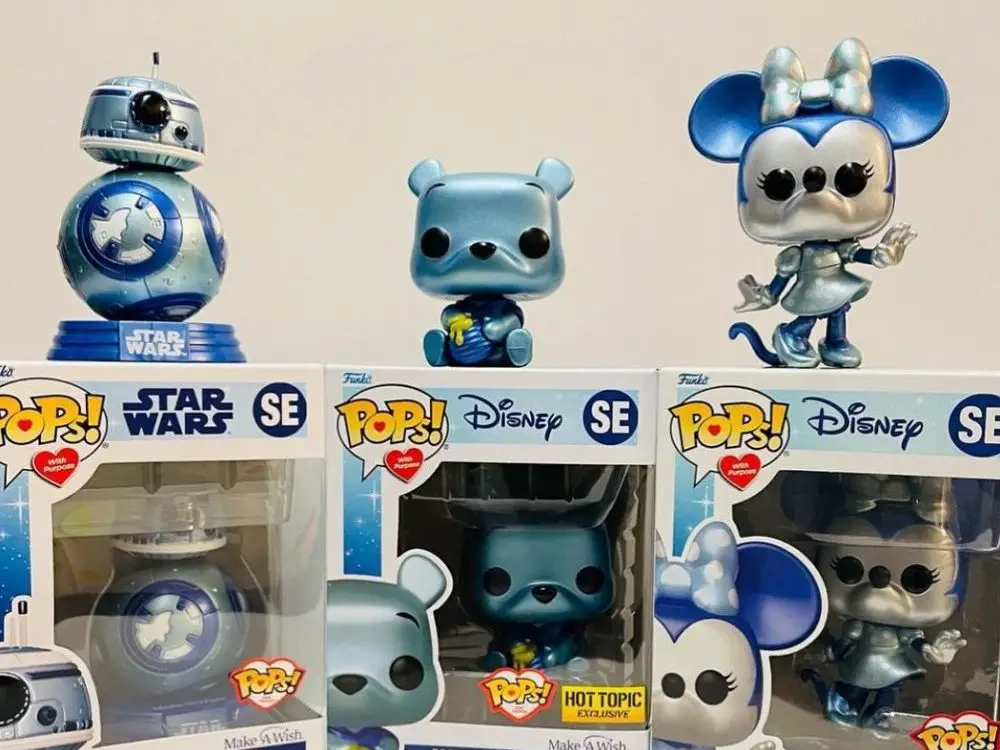When you think about a collector, what’s the first image that comes to mind? Do you imagine someone with a mountain of memorabilia for their favorite media, or a simple, shelf-bound shrine of stuff? Regardless of what a collector “looks like,” it’s safe to assume that their collections display all that internal fan love in a tangible form. But are there any obstacles to collecting that one should look out for? As a hobby that seems to accommodate the time and pace of the collector, it seems too convenient for anything to get in the way.
However, recent events described by Retail Insider allow onlookers to examine the collector’s roadblock through the lens of Funko Pops. The Funko phenomenon was recently brought back to the front of this conversation, but a new focus was placed on how these little toys gain high value in the resale market. Funko Pops get a front-row seat to a discussion of an item’s value, and what the chase to snatch up these limited-edition goods looks like when others are manipulating the market in their money-hungry favor.
Before they were a worldwide selling and reselling sensation, Funko Pops started as a fresh, new take on nostalgic collectibles. Founded in 1998 by Mike Becker, the Funko Inc. company broke out into the toy scene with a singular bobblehead, modeled after the restaurant mascot “Big Boy.” This character joined a collection of Wacky Wobblers bobbleheads, to introduce the world to the big-headed, mini-figurines that would become the face of the company. In 2011, after changes in leadership and the addition of products, Funko Inc. took a culture-shifting turn with the debut of the Pop! Vinyl line. These four-inch figurines combine the novelty of a dashboard bobblehead, with the iconic images of some of pop culture’s beloved characters.
While the company does have a wide product inventory ranging from action figures, clothing and even teensy charms to deck out almost anything, it is the Pop! Vinyl line that put Funko Inc. on the media map. Fast forward to today, the Funko brand name has become synonymous with collecting in a 2022 world. There’s something intriguing about Funko Pops as not-your-average action figures, which causes fans from every fandom to swarm new lines of the product.
Based on the Japanese “Chibi” style of art, their iconic short stature and big heads are a sight that keeps collectors coming around. To cause “a new addiction fans never knew they were craving” is an impressive feat for a little collectible; but what does this craving for Funko Pops look like? The company’s bold mix of nostalgia and pop-cultural references work together so that “entertainment enthusiasts display their fandom through the lens of Funko products.” Fans also refer to Funko Pops as simply “Pops,” which affirms their casual and constant presence among collectible memorabilia. Since the response to Pop! Vinyl figurines helped put the “fun” in Funko Pops, it’s no surprise that the fans’ demand to grow their collection keeps the company going.
While Funko Pops continue to dominate collectors’ attention, the gloomier setback of growing collections is seen through toy resales. In a recent Twitter event by Retail Insider, a discussion broached the topic of “reselling” Funko Pops for excessive profits. Besides the fact that the resale of “Pops” is not a new practice, the high prices sometimes fetched by Funko Pops sparked conversation on the toys as a “breakout” market to enter. As the thread pointed out, the Pops! Vinyl figures become extremely valuable assets based on the state of the product: “The exclusivity of certain figures can boost their value to hundreds or thousands of dollars in the secondary market, especially if the box is in mint condition.” A darker and almost “sneaky” side of collecting Funko Pops is exposed through “judging” a product’s worth under these expectations.
While this Twitter event indicates how collecting Funko Pops has changed the fandom landscape, the analysis does raise the question of what makes a product a “worthwhile” investment. From collector to reseller, where is the line drawn between collecting items for honorable means, and pursuing goods for money-hungry mayhem? Platforms like eBay and Whatnot allow sellers to capitalize on Funko Pop’s high-demand nature, to bring in sums that can indicate 1000% increases from what was originally paid for the item. Nonetheless, knowing that Funko Pops have become a “pop” staple for today’s multimedia cultures has forced collectors to be more cautious about where they’re getting their money’s worth.
But how does a toy become a moneymaker? Peeling back the layers of actual resale listings could explain the gravity of the situation. A quick eBay search for “Funko Pops” yields an intimidating list even for the savvy shopper. With over 600,000 different results under the category, the hunt is on for either the best deals or the rarest items. Luckily, toggling the filter to show the highest prices first highlights Funko Pops going for five-figure price tags.
Among the list is a “Holographic Darth Maul” figurine selling for $15,000. This specific version of the Star Wars character, which was only sold at the 2012 San Diego Comic-Con, evidently gets its high price point from its rarity and short production run. In the same vein, limited editions of celebrity Pop! Vinyls are a smash hit online: a metallic Funko Pop figurine of the late Stan Lee is posted for a whopping total of $75,000. Since Funko Pops tend to represent fictional pop culture more so than their celebrity counterparts, the chase for Pops like Stan Lee adds an extra layer of desire to the toy.
To put these numbers into perspective, the average Funko Pop figurine retails for about $10-$15, based on Funko’s “Best Sellers” website category. This means that resellers are making profits that could pay for the original product a thousand times over – no exaggeration necessary. Essentially, the resellers raise the stakes in the already-difficult hunt for collectibles, by beating collectors to the product. As one blog dedicated to Pop and Figures remarked on the issue, resellers “chase after certain valuable items and hold on to them to create an artificial scarcity to shoot up the prices.” By imposing a sense of “fear of missing out” on a limited edition product, the value of the “Pops” rises and allows the reseller to turn the snatched-up collectible into cold-hard cash.
Additionally, an entire subsection of YouTube dedicated to “Funko Pop Resellers” explores the “industry” of turning “Pops” into profits. For example, a 2021 video titled “How to Make Money Selling Funko Pops – Step by Step” discusses a handful of benefits of getting into the side hustle of Funko Pops resale. To make his position more convincing, Dr. Applesauce highlights the fulfillment of buying from resellers: “I’m not spending thousands of dollars at Walmart, or Target, or Funko Shop; I’m actually giving real people money to do things with.”
Even if there are well-intentioned sellers who might take this advice to break into the Funko Pop community, there will always be individuals who only see this as generating pocket cash from cashing in the “Pops.” Placing videos like the one from Dr. Applesauce in contrast to channels like Top Pops, which spread smiles from the joy of collecting Funko Pops, the spectrum of collectors’ motivations is wide-ranging and controversial. On one hand, there is a sense that a real profit can “pop up” from the Funko Pops “industry.” Yet the reality of the ridiculous and almost laughable price increases for a toy ends up distracting from the best parts of owning collectibles in the first place.
At the core of the collector’s experience, the act of gathering memorabilia provides a tangible exploration of one’s interests. Courtesy of Funko’s own blog, “The beauty of being a collector is that there are no right or wrong answers. There are only collectibles that bring you joy and those that don’t.” The hobby of collecting serves as one of the rarest outlets that have no set “definition” or benchmark that one must meet. Whether a person has one piece or one million pieces dedicated to a certain form of media, they’re a collector all the same because of their fan-based intentions behind collecting. Collectors often use Funko Pop protectors to keep them pristine, enhancing their value and appeal.
Turning back to the fans of Funko, “The Pops give them a chance to have a physical representation of their cult heroes that they couldn’t meet.” This statement echoes the origins of Funko Pops as a means of representing one’s fictional favorites — those present in “pop” culture — in beloved, souvenir form. However, the collector’s joy transforms into chaos when the character figurines are overturned in favor of three, four and even five-figure price tags. Even if resale items could contribute “rare finds” to the community of collectors, obtaining the toys for the sole purpose of flipping a profit butchers the hobby.
For one thing, it’s important to note that the full article mentioned in the original Twitter highlight is locked behind a paywall, granting cruel irony to a story about the monetary “value” of an item. The skewed focus on the event focuses heavily on Funko Pops as a hot commodity, with very few descriptions about all the wonderful things Funko has done for fandom connections. At the end of the day, the Funko Pops are for the fans who are fond of fiction and prefer a physical relic to represent that love. To sell or not to sell becomes a complex situation when we forget that these tiny figurines gain emotional value from the collectors who seek them out. Putting aside the fact that even the Funko Pops site has tailored advice for official Funko resellers, the sellers who mark up figurines for exorbitant prices are the ones sparking chaos in the collectible community.
No matter where the resale “trend” may go, it cannot be advertised as a “niche market” without acknowledging all the fans and die-hard collectors that have made it possible. As fictional movies and television shows became a staple of the mainstream conversation, so did a new need come about for repping favorite fandoms. The results of the figurines making their way into collectors’ hearts definitely show: Even just one Funko Pops toy exposes a person to “a friendly world of collectors who share their massive collections and fondness for being kids again.” In 2022, about 166 different Funko Pops are scheduled to be released throughout the year. With all these Funko Pops “popping” up in the market, the question of value will only continue to grow alongside — and over — the sticky resales that try to steal the collector’s joy.











